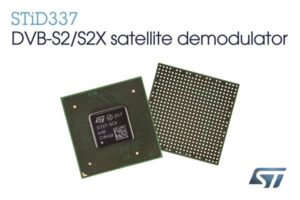Eutelsat Communications and STMicroelectronics have achieved a new milestone with a new-generation chip that will power Eutelsat’s SmartLNB interactive terminal.
 ST’s advanced, low-power System-on-Chip (STiD337) represents a big step down in the overall cost of interactive satellite terminals. The STiD337’s first adoption is in Eutelsat’s SmartLNB, lowering cost, upgrading service, and significantly reducing power consumption.
ST’s advanced, low-power System-on-Chip (STiD337) represents a big step down in the overall cost of interactive satellite terminals. The STiD337’s first adoption is in Eutelsat’s SmartLNB, lowering cost, upgrading service, and significantly reducing power consumption.
The SmartLNB is an electronic feed that replaces the traditional Ku-band reception of DTH satellite signals, embedding one or more satellite tuners/demodulators directly inside the LNB (low-noise block) and adding a narrowband return link optimized for transmissions of IP packets. The SmartLNB enables a wide range of connected TV applications, providing a transparent bidirectional IP link compatible with existing services. Not limited to the TV and broadcast market, applications also cover the exploding sector of connected objects (Machine-to-Machine, Internet of Things, SCADA, home-automation, Smart Buildings, etc.) with a cost-effective solution via satellite.
ST has employed its very low-power 28nm FD-SOI (Fully Depleted Silicon on Insulator) process technology that enables deep sleep and auto wake up for the system. With a maximum 3.5W power dissipation at full speed and less than 50mW (typical) during sleep, the STiD337 is the most power-efficient device available today to take the SmartLNB to a new level of performance and efficiency.
The STiD337 adds the latest DVB-S2X satellite standard for the forward link, as well as GSE (Generic Stream Encapsulation) for efficient data handling; it can achieve throughput of over 100Mb/sec. The return path implements a software-radio approach that is optimized for the enhanced spread-spectrum technique with asynchronous access typically used for the SmartLNB. The device also includes the full complement of hardware mechanisms to support real-time multiple-access techniques. The return modulation is calculated on the internal processors. The platform includes a dual ARM® Cortex®-A9 core with NEONTM co-processors and four ST231 DSP offload coprocessors to enhance its compute power and ensure complete flexibility in the choice of return-channel modulation type.
The new SoC will be available in secure and standard versions. The secure version includes pre-loaded encryption keys, serial numbers, safe-boot, and many other features to increase the level of protection of data-delivering and gathering operations by the SmartLNB.
ST provides a hardware evaluation platform, a Linux-based operating system, and a basic driver set. Final production samples of the STiD337 are available now and full production is scheduled for May 2017. Further information is available on ST.com and under NDA.

Leave a Reply